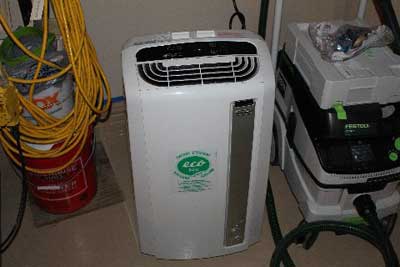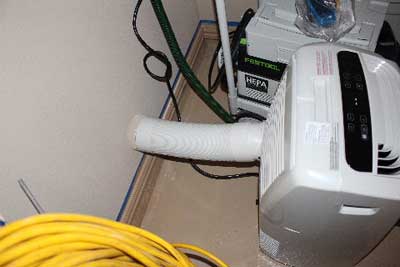
In the last eZine, Rob noted that we Minnesotans were feeling more comfortable in our souls with the well-below-zero temperatures and windchills we were experiencing. He asked how the rest of you dealt with heating your shop – and you told us. (Although we do admit to not really feeling any sympathy for those who think winter weather that doesn’t get below the 20s or 30s Fahrenheit is “cold.”) – Editor
“While I live in SE Lousy Anna (Louisiana), we do get some pretty nasty, cold weather here. Take, for instance, this morning, when I had 1/4” of ice on my windshield. On Thursday, we are supposed to get into the upper 20s, so I would say that qualifies as cold weather. My usual solution: either stay out of the shop, which amounts to half of my double-wide garage, or I wait until the afternoon when the sun will pour in, if we have sun, through the open west-facing garage door. That can heat it up pretty quickly if we have minimal winds. Mostly, I just opt for the “stay-in-the-warm-house” routine, sitting at the computer reading your latest copy of Woodworker’s Journal. That helps pass the time productively, at least. That, and I also get to send off some witticism to you occasionally.” – Bob Hoyle
“Glad you asked, my friend. I guess some folks think that us good ole Southern boys don’t get cold, but I have news for you, my man. By golly, it gets a little chilly down here in north Texas. Some folks think we’re in Oklahoma since Celina, Texas is so close to the border. Yea, that Mr. Freeze himself will run to the south every once in a while and, when my weekend hits, I don’t like giving up my workshop time since it is my retreat from my daily routine of sales during the weekdays. I can’t wait for the weekends when it’s just me, my two Alaskan malamutes, my SiriusXM® radio with Prime Country blaring and the almighty sounds of my tools ripping another piece of oak that will eventually end up being a part of a new piece of something being built by my God-given hands.
“Now, how do I stay warm when Old Man Winter hits us Southern folks hard, you ask? Well, I had the builder insulate first of all the ceilings and walls in my 14′ x 40′ workshop (with a 20′ x 20′ two-cart portion), and the two doors are insulated as well. The HVAC folks put me in two exhaust ports in my outer wall of the workshop. How about the summer heat waves we get here in Texas? Got that covered as well. While we were in the building and planning stages of the home, I was doing everything I could to think of everything I would or could use in the shop. The HVAC was the primary thing that was on my mind, because I have tried to work in a garage/shop when it was below freezing outside and believe me, Rob, it’s not easy with those gloves on. I found the De’Longhi brand portable units on sale at Costco and bought myself two that would heat, cool and dehumidify up to 500 square feet of space each. At present, I have run the electrical to the one in the front of the shop and have had to turn it off a couple of times while getting the shop prepared to work in. I chose to run all of my electrical and lights myself along with all of the other shop items that makes a shop a real place to work: air filter, pipes for the dust collector and so on.” – Dennis Young
OK, this one is from Saskatchewan. We’ll grant that it does get cold up there. – Editor
“I have two garages in Regina, Saskatchewan, that I use for shops. Both of them are heated, one with an old counter flow furnace that will be replaced as soon as I finish re-insulating both shops. My second shop is heated with in-floor radiant that runs off a boiler from my house. I started off the heating season fixing both the boiler and counter flow furnace. So far everything is working fine, so keeping fingers crossed. Hopefully the car will disappear out of my front shop long enough for me to get my new fence installed on my table saw. That’s how my life seems to go.” – Gord Williams
“I live in east central Illinois, out in the country on my farm. Several years ago, when propane was skyrocketing, I purchased a used pellet-burning fireplace insert and heated my home with it, burning wood pellets or dry field corn. I have not used my propane furnace in the last six years. Two years later, a friend of mine had a small wood pellet stove that he was wanting to trade out. I got it and placed it in my 27 X 30 woodshop and took out my woodburning stove. The stove served its purpose, but the pellet stove is thermostatically controlled, and burns very little in keeping my shop around 60 degrees, which is my comfort zone for working. I like the thought that I am heating with a renewable fuel, and even that it is compressed sawdust.” – Craig Potter
“True, it doesn’t get much below 30 degrees in south Louisiana, but we still need a little heat. I know three fellow woodworkers that use wood heaters to heat their shops. I guess over the years I have became soft and put central air and heat in mine. I like to keep it around 70 degrees in my shop the year-round. I hate to sweat all over my wood.” – Charles Cassidy
“My central Arkansas shop is a much-too-crowded 24×30 building. When I purchased my house, it had a Hardy Woodburning Heater outside to heat the house and consumable hot water. I had considered using hot water off that unit to heat the shop, but opted instead to sell it and with the proceeds, I insulated and drywalled the shop and purchased a 14,000 BTU PTAC heat pump with 3.5KW supplemental heat strips. This is the type of unit you see in hotel rooms; many are simply an AC unit with the heat strips, but I opted for the heat pump model. I absolutely love it. I actually keep the shop climate-controlled year-round. This has eliminated all cast-iron rust problems, and I can now keep things that would be damaged by freezing temps (paint, glue, etc.) in the shop year-round. The only time the heat strips come on is when I raise the temp from normal winter carrying temp of 62 to my comfortable working temp of 68. Other than that, the heat pump pretty well takes care of the heat requirements. This unit would be woefully inadequate without the insulation, but with it, the unit is spot on.” -Rick Martin
And at least some of you admitted, albeit in a roundabout manner, that your weather can really only be classified as “warm.” – Editor
“You should know better than to ask such an open-ended question. I could not resist. During the holidays, it was rather cold here. Some days it did not get up to 70° and at night we got as low as 40°. How do I deal with the cold weather? I insulated the garage with paper-backed fiberglass (R-13 in walls and R-19 in attic). With the garage door open, it seems to be 5° warmer in winter and 5° cooler in the summer. On those really cold days, I’ll wear two T-shirts. Yesterday it didn’t quite get to 80°, and right now it is only 76°.
“When you get to the point of selling the snowblower and dumping the tire chains, think about southern California. The weather is so mild and even year-round. The maximum temperature spread here in Huntington Beach from low to high might be 55°. (Winter night to summer hottest day) Humidity is rare and the style of living is very relaxed.” – Rich Flynn
“Living in the Northwest, we don’t get the cold as bad as your neck of the woods. We may get a week of cold teens at night to upper 20s/lower 30s during the day; however, we do have the dampness. I heat both my house and my shop with wood stoves, which works just fine. I don’t burn much shop scraps because I don’t throw much out (some would say I am a wood hoarder; I would have to agree with them ), but living where I do, firewood is not hard to find.” – Jack Getzler
“We should be in the middle of the monsoon [in Australia] about now, but with a drought on, the rain has been ‘wimpy.’ The heat and humidity have stepped right up to the plate to make up for it, though. We’ve finally had a splash or two of rain, but about all that has achieved is to bring the snakes out. We extended the shed (“shop,” to you) a couple of years ago and insulated the new roof sections. A couple of rows of solar panels will no doubt shade part of it, too.” – Mike Newman







